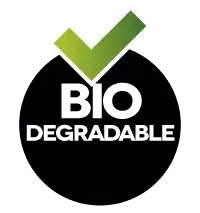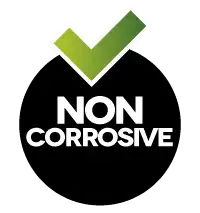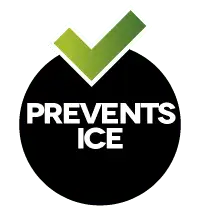
Eco-Friendly De-Icer for Sale Non-Toxic Ice Melt for Driveways & Walkways
Looking for an eco friendly de-icer that actually works? Discover EcoGrit’s non-toxic, pet- and plant-safe ice melt – perfect for UK driveways and walkways.
Organic and Concrete Safe De-icer
It can be all too easy to simply chuck down some rock salt on an icy or snowy road to clear it quickly on a frosty morning or to try to make it safer for your family to walk on. However, despite its rapid results, the longer-term consequences can take a lot more time to mitigate against, as they can reach much further afield and much deeper than the initial application of rock salt or sodium chloride.
Concrete, in particular, is open to damage and weakening as a direct result of being exposed to rock salt during the winter months. Despite it appearing to be a hard, robust and practical surface material, it can be subject to damage from seasonal temperatures, weather conditions and, above all, applying the wrong kind of snowmelt.
Concrete is a porous material, meaning that it absorbs water and other liquids easily. This is often observed during a rainy day when the falling raindrops penetrate the surface of the concrete instead of resting on its surface or bouncing off it. This becomes more of a problem, however, during colder months, especially when the temperature regularly dips below freezing. This produces what is known as the ‘freeze-thaw effect’, which can seriously damage concrete.
As water is absorbed into the concrete during temperatures that are above zero degrees C, it stays there as it is too cold for it to evaporate away. When the temperature goes below zero, the water freezes, taking up extra space as a solid and ends up cracking or splintering the surrounding concrete. When the ice melts back into the water, it runs off, widening the cracks and going deeper into the concrete for the cycle to start all over again when the temperature lowers once more.
Freeze-thaw damage can show as flaking, cracking and chipping of the concrete, which looks unattractive and affects the integrity of the surface. Add to those heavy vehicles driving on and off the driveway and people and animals wearing it away further with constant walking across it, and the damage can quickly get a lot worse if left unrepaired.
When you use rock salt on concrete, adverse effects will only add to these problems, as the salt attracts additional moisture and so further weakens any concrete it comes into contact with. Just as water from the melting ice can pass easily into the concrete and stay there, so can any salt that has been dissolved in it, lengthening the contact time and exacerbating the damage. Other non-concrete safe salt or ice melt products contain additional harmful ingredients such as calcium chloride or potassium chloride, which are not conducive to maintaining robust, safe concrete surfaces in winter.
Where rock salt is applied to concrete exterior surfaces such as steps, ramps or slopes, the extra cracking and splintering it can cause poses a further risk to people walking on it, as they can be more prone to trips and slips over the more uneven ground. Broken pieces of concrete can become lodged in the soles of people’s shoes and then be brought inside the house to damage rugs and carpet, or even trapped in the delicate paws of any pets walking across the surface, causing painful cuts and bruises. They can also fly up into the air if hit at the wrong angle to damage passing vehicles or nearby equipment or surfaces.
EcoGrit
The Saw Mill
Brooms Barn
Coney Weston
IP31 1HQ

Looking for an eco friendly de-icer that actually works? Discover EcoGrit’s non-toxic, pet- and plant-safe ice melt – perfect for UK driveways and walkways.
Discover how to stay ahead of winter weather with EcoGrit’s expert guidance on de-icing. Learn about our legal responsibilities and how you can keep your
The information above may leave people wondering whether there is an ice-melt or salt that doesn’t damage concrete. One of the safest ice melts for concrete is EcoGrit, a naturally derived ice melt safe for pets and concrete alike. EcoGrit contains no corrosive ingredients that can cause salt damage to concrete that results in it splintering or cracking. It is eco-friendly too, meaning that any EcoGrit granules dissolved in melting water will not harm the surrounding environment or local wildlife.
EcoGrit works well on a wide range of exterior surfaces alongside concrete and is quite safe to be applied on tarmac, paving stones and resin-based materials. It can be applied the night before and works for up to seven days, meaning that each exterior surface can be treated fewer times, lessening the impact of the materials on the concrete below.
The good news is that there are products available that effectively deice driveways and other frosty exterior surfaces without using harsh chemicals or rock salt. EcoGrit is one such product containing no rock salt or ammonia. It works on driveways down to minus 20 degrees C for up to seven days. It can also be applied early to stop ice forming on a driveway in the first place.
Many deicers use rock salt, or sodium chloride, as the active ingredient to lower water’s freezing temperature and so melt ice or snow from surfaces. However, rock salt contains many harmful chemicals that can damage people, pets, vehicles, and wildlife habitats. Other damaging ingredients in standard deicers include urea, ammonia, and urea, all of which work to lower freezing points. For the most environmentally friendly approach to deicing, look for products with organically derived ingredients that will not harm the environment, such as EcoGrit.
As well as applying a concrete safe ice melt to melt ice and snow safely before it penetrates too deeply underneath the surface, there are other ways to help prevent it from cracking, splintering or breaking under the strain of colder temperatures and wetter conditions. In areas where the concrete is freshly laid, or particularly vulnerable, laying an insulating frost blanket over it during especially cold nights can help. Pay attention to more fragile areas, such as the sides of slabs, any existing cracks and places where the concrete is wearing thin.
Other ideas can include adding windbreaks or even outdoor heaters to remove the worst of the chill. If you can avoid driving in more vulnerable areas, do so, and never use rock salt ice melt on it for the reasons listed above. Instead, choose a concrete safe ice melt such as EcoGrit to achieve effective ice and snow removal while keeping surfaces as safe and strong as possible. Get any cracks or damaged patches fixed as quickly as possible, using a waterproof sealant to fill them in and help ward off excess water ingress. Keep the general area well maintained and well-lit so you can spot any damage quickly and help people to avoid any uneven areas while walking across it. If you are at all unsure about how to repair any cracks or damage to your concrete, call in a professional company to take a look at the job for you and so save you the hassle of larger problems further down the line. Finally, always keep a container of EcoGrit close by to help protect your concrete when seasonal temperatures fall.




While sodium chloride, or rock salt, doesn’t react chemically to concrete, it does attract moisture, which then enters the concrete along with any falling rain, snow or sleet. The rock salt can melt frozen water on the concrete’s surface, but in doing so, it causes damage to the surface in other ways, including corrosion and cracking.
Moisture from rock salt exacerbates the ‘freeze-thaw’ effect, of ice and snow on concrete, which sees water absorbed by the concrete freeze solid inside it, taking up more room and cracking it, then melting away again, taking corrosive salt with it into the surrounding ecosystems. A salt-free, safer ice melt like EcoGrit will not have such an adverse effect on concrete.
Applying rock salt to concrete will melt the frozen ice or snow on top of it; however, this will also cause damage to the concrete due to the salt attracting excess moisture that cracks the surface, as well as its own corrosive properties. It is far better to use a salt-free, concrete safe ice melt such as EcoGrit to melt any frozen ice or snow on top of concrete.
Deicers lower the point at which water freezes by changing its chemical make-up. It creates a solution that does not freeze at the same point as water, thus melting the solid water and turning it back into liquid. As the solution spreads across the frozen surface, it melts the water underneath. This runs safely off the surface, removing the slippery coating and making it safer to walk or drive on. This is how EcoGrit works, amongst others.
We would appreciate people to like and follow our social media streams to help spread the word, educate and enlighten others and help to start making a real difference.






EcoGrit is an environmentally conscious company that would like to serve the people by offering them education, insight, “peace of mind” and the chance to make a positive difference on a monumental scale at a time when winter weather patterns are becoming more unpredictable.
VAT (Value Added Tax) Number: 340 3662 26
Looking for an eco friendly de-icer that actually works? Discover EcoGrit’s non-toxic, pet- and plant-safe ice melt – perfect for UK driveways and walkways.
© 2023 EcoGrit Ltd